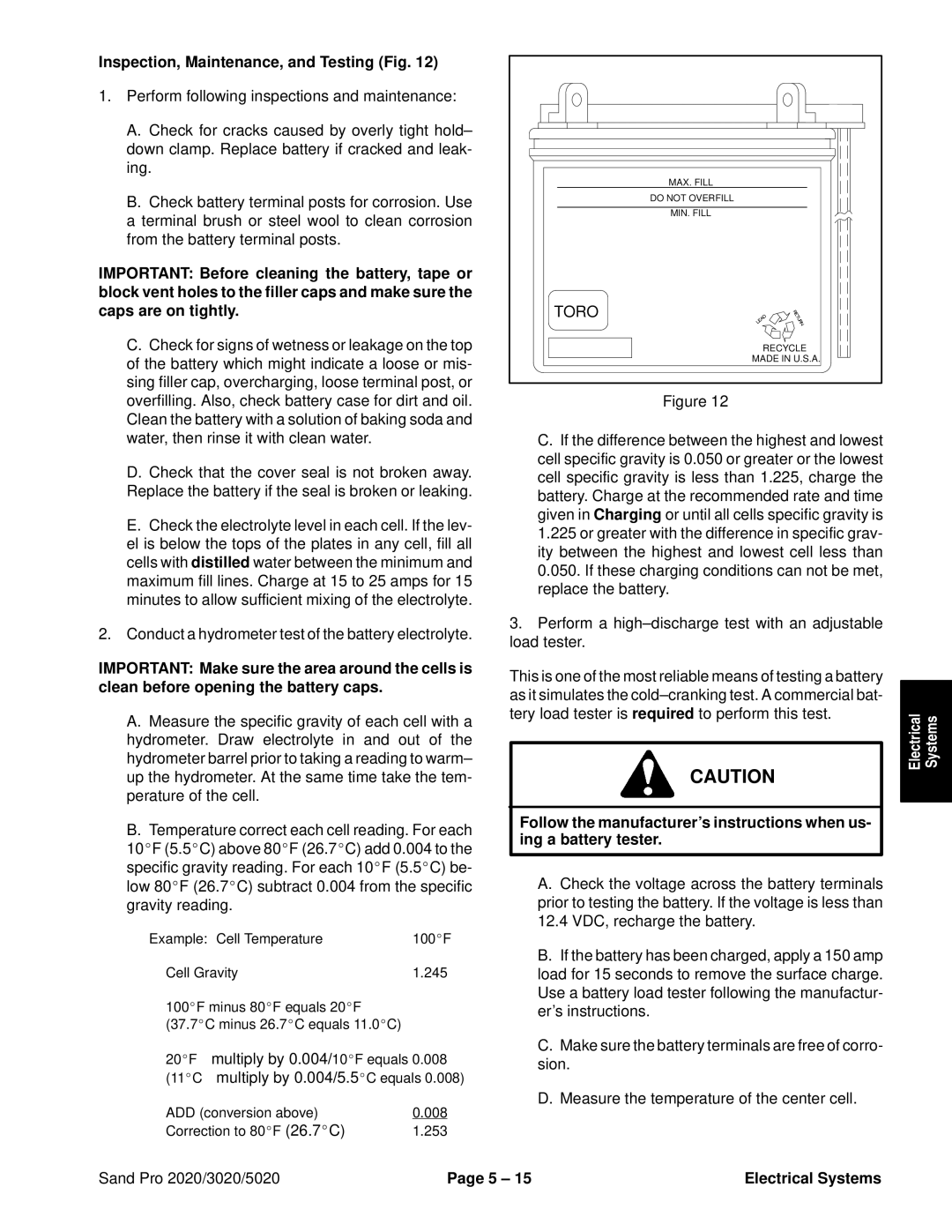
Inspection, Maintenance, and Testing (Fig. 12)
1.Perform following inspections and maintenance:
A.Check for cracks caused by overly tight hold– down clamp. Replace battery if cracked and leak- ing.
B.Check battery terminal posts for corrosion. Use a terminal brush or steel wool to clean corrosion from the battery terminal posts.
IMPORTANT: Before cleaning the battery, tape or block vent holes to the filler caps and make sure the caps are on tightly.
C.Check for signs of wetness or leakage on the top of the battery which might indicate a loose or mis- sing filler cap, overcharging, loose terminal post, or overfilling. Also, check battery case for dirt and oil. Clean the battery with a solution of baking soda and water, then rinse it with clean water.
D.Check that the cover seal is not broken away. Replace the battery if the seal is broken or leaking.
E.Check the electrolyte level in each cell. If the lev- el is below the tops of the plates in any cell, fill all cells with distilled water between the minimum and maximum fill lines. Charge at 15 to 25 amps for 15 minutes to allow sufficient mixing of the electrolyte.
2.Conduct a hydrometer test of the battery electrolyte.
IMPORTANT: Make sure the area around the cells is clean before opening the battery caps.
A.Measure the specific gravity of each cell with a hydrometer. Draw electrolyte in and out of the hydrometer barrel prior to taking a reading to warm– up the hydrometer. At the same time take the tem- perature of the cell.
B.Temperature correct each cell reading. For each 10_F (5.5_C) above 80_F (26.7_C) add 0.004 to the specific gravity reading. For each 10_F (5.5_C) be- low 80_F (26.7_C) subtract 0.004 from the specific gravity reading.
Example: Cell Temperature | 100_F |
Cell Gravity | 1.245 |
100_F minus 80_F equals 20_F
(37.7_C minus 26.7_C equals 11.0_C)
20_F multiply by 0.004/10_F equals 0.008 (11_C multiply by 0.004/5.5_C equals 0.008)
ADD (conversion above) | 0.008 |
Correction to 80_F (26.7_C) | 1.253 |
MAX. FILL |
DO NOT OVERFILL |
MIN. FILL |
TORO |
RECYCLE |
MADE IN U.S.A. |
Figure 12
C.If the difference between the highest and lowest cell specific gravity is 0.050 or greater or the lowest cell specific gravity is less than 1.225, charge the battery. Charge at the recommended rate and time given in Charging or until all cells specific gravity is 1.225 or greater with the difference in specific grav- ity between the highest and lowest cell less than 0.050. If these charging conditions can not be met, replace the battery.
3.Perform a
This is one of the most reliable means of testing a battery as it simulates the
CAUTION
Follow the manufacturer’s instructions when us- ing a battery tester.
A.Check the voltage across the battery terminals prior to testing the battery. If the voltage is less than 12.4 VDC, recharge the battery.
B.If the battery has been charged, apply a 150 amp load for 15 seconds to remove the surface charge. Use a battery load tester following the manufactur- er’s instructions.
C.Make sure the battery terminals are free of corro- sion.
D.Measure the temperature of the center cell.
Electrical | Systems |
|
|
Sand Pro 2020/3020/5020 | Page 5 – 15 | Electrical Systems |
